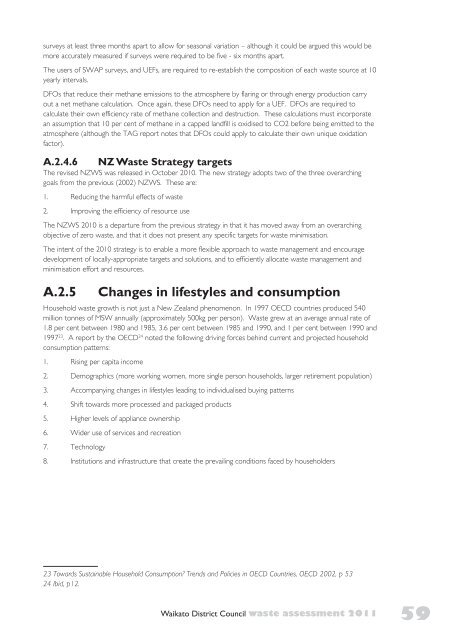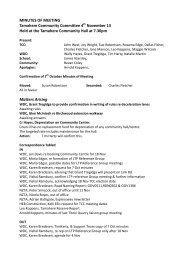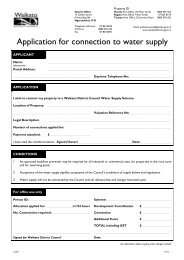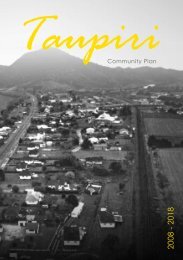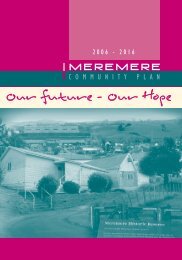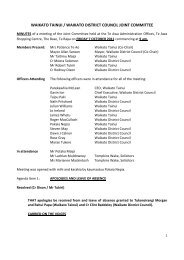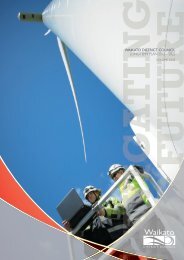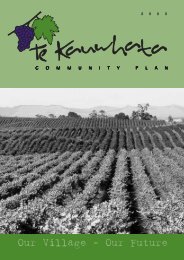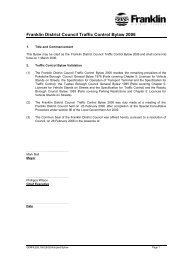goal <strong>of</strong> the Fund, and ensure that their application demonstrates a contribution to these goals.The latest information available on the fund suggests that the main <strong>assessment</strong> point is likely to be whatthe Ministry describe as ‘largest net benefit over time’ eg amount <strong>of</strong> <strong>waste</strong> diverted from landfill per dollar<strong>of</strong> funding), alongside supporting criteria such as likelihood <strong>of</strong> success, reducing environmental harm, widersustainability benefits, and longevity. Projects that can act as trailblazers for the rest <strong>of</strong> New Zealand will also befavoured. The Ministry strongly encourages partnership working and collaboration.While no minimum ‘match’ funding has been specified, the Ministry has made it clear that projects with higherlevels <strong>of</strong> match funding will be seen as demonstrating successful collaboration and a greater likelihood <strong>of</strong> successand longevity.The first funding round opened on 1 December 2009, and applications closed at 5pm on 1 March 2010.Successful projects commenced in August 2010. The next funding round ran during in January – March2011, with projects starting in August/September 2011. A third round is expected in late 2011 and MfE hasannounced that <strong>this</strong> will be a ‘targeted’ round.A.2.4.5Emissions Trading Scheme (ETS)In its current form, The Climate Change (Emissions Trading) Amendment Act 2008 will require landfill ownersto surrender emission units to cover methane emissions generated from the landfill, thereby impacting on thecost <strong>of</strong> landfilling. Should any future solid <strong>waste</strong> incineration plants be constructed, the Act would also requireemission units to be surrendered to cover carbon dioxide, methane and nitrous oxide emissions from theincineration <strong>of</strong> household <strong>waste</strong>s. The <strong>waste</strong> sector will not formally enter the ETS until 1 January 2011, atwhich time voluntary reporting can occur. Mandatory reporting requirements will apply from January 2012 andemission units will need to be surrendered as <strong>of</strong> 2013.Emissions for <strong>waste</strong> will be accounted for within the year that the <strong>waste</strong> is disposed <strong>of</strong> to landfill – ie the totalamount <strong>of</strong> methane that <strong>waste</strong> is expected to produce will be calculated, reported, and require NZUs in theyear it goes to landfill. This does mean that closed landfills will not require any reporting or NZUs. ‘Legacy’closed landfills have been excluded from the ETS.The definition <strong>of</strong> a disposal facility will be the same as applies in the Waste Minimisation Act (2008).This DEF assumes that no landfill gases are collected or destroyed in any way, and incorporates an assumptionthat 10 per cent <strong>of</strong> methane in a capped landfill is oxidised to CO2 before being emitted to the atmosphere.For a DFO to use a UEF, they must carry out a prescribed Solid Waste Analysis Protocol (SWAP) surveyprocess for a year’s <strong>waste</strong>. This SWAP survey must categorise the <strong>waste</strong> by source, as municipal solid <strong>waste</strong>,commercial and industrial, building and demolition, and other. Within each source, the fraction <strong>of</strong> the following<strong>waste</strong> materials must be calculated: food <strong>waste</strong>, garden <strong>waste</strong>, paper, wood, textiles, nappies, sewage sludge,and other.For each <strong>of</strong> these <strong>waste</strong> materials, a standard proportion <strong>of</strong> degradable organic carbon (DOC) has beencalculated. These are shown in Table 23. ‘Other materials’ are assumed to have zero DOC.Table 23: Proportions <strong>of</strong> degradable organic carbon, by materialWaste materialDOCFood <strong>waste</strong> 0.15Green <strong>waste</strong> 0.20Paper 0.40Wood 0.43Textiles 0.24Nappies 0.24Sewage sludge 0.05The regulations require landfill operators to undertake two <strong>waste</strong> surveys over a 12 month period with the58
surveys at least three months apart to allow for seasonal variation – although it could be argued <strong>this</strong> would bemore accurately measured if surveys were required to be five - six months apart.The users <strong>of</strong> SWAP surveys, and UEFs, are required to re-establish the composition <strong>of</strong> each <strong>waste</strong> source at 10yearly intervals.DFOs that reduce their methane emissions to the atmosphere by flaring or through energy production carryout a net methane calculation. Once again, these DFOs need to apply for a UEF. DFOs are required tocalculate their own efficiency rate <strong>of</strong> methane collection and destruction. These calculations must incorporatean assumption that 10 per cent <strong>of</strong> methane in a capped landfill is oxidised to CO2 before being emitted to theatmosphere (although the TAG report notes that DFOs could apply to calculate their own unique oxidationfactor).A.2.4.6NZ Waste Strategy targetsThe revised NZWS was released in October 2010. The new strategy adopts two <strong>of</strong> the three overarchinggoals from the previous (2002) NZWS. These are:1. Reducing the harmful effects <strong>of</strong> <strong>waste</strong>2. Improving the efficiency <strong>of</strong> resource useThe NZWS 2010 is a departure from the previous strategy in that it has moved away from an overarchingobjective <strong>of</strong> zero <strong>waste</strong>, and that it does not present any specific targets for <strong>waste</strong> minimisation.The intent <strong>of</strong> the 2010 strategy is to enable a more flexible approach to <strong>waste</strong> management and encouragedevelopment <strong>of</strong> locally-appropriate targets and solutions, and to efficiently allocate <strong>waste</strong> management andminimisation effort and resources.A.2.5Changes in lifestyles and consumptionHousehold <strong>waste</strong> growth is not just a New Zealand phenomenon. In 1997 OECD countries produced 540million tonnes <strong>of</strong> MSW annually (approximately 500kg per person). Waste grew at an average annual rate <strong>of</strong>1.8 per cent between 1980 and 1985, 3.6 per cent between 1985 and 1990, and 1 per cent between 1990 and1997 23 . A report by the OECD 24 noted the following driving forces behind current and projected householdconsumption patterns:1. Rising per capita income2. Demographics (more working women, more single person households, larger retirement population)3. Accompanying changes in lifestyles leading to individualised buying patterns4. Shift towards more processed and packaged products5. Higher levels <strong>of</strong> appliance ownership6. Wider use <strong>of</strong> services and recreation7. Technology8. Institutions and infrastructure that create the prevailing conditions faced by householders23 Towards Sustainable Household Consumption? Trends and Policies in OECD Countries, OECD 2002, p 5324 Ibid, p12.<strong>Waikato</strong> <strong>District</strong> <strong>Council</strong> <strong>waste</strong> <strong>assessment</strong> 201159


